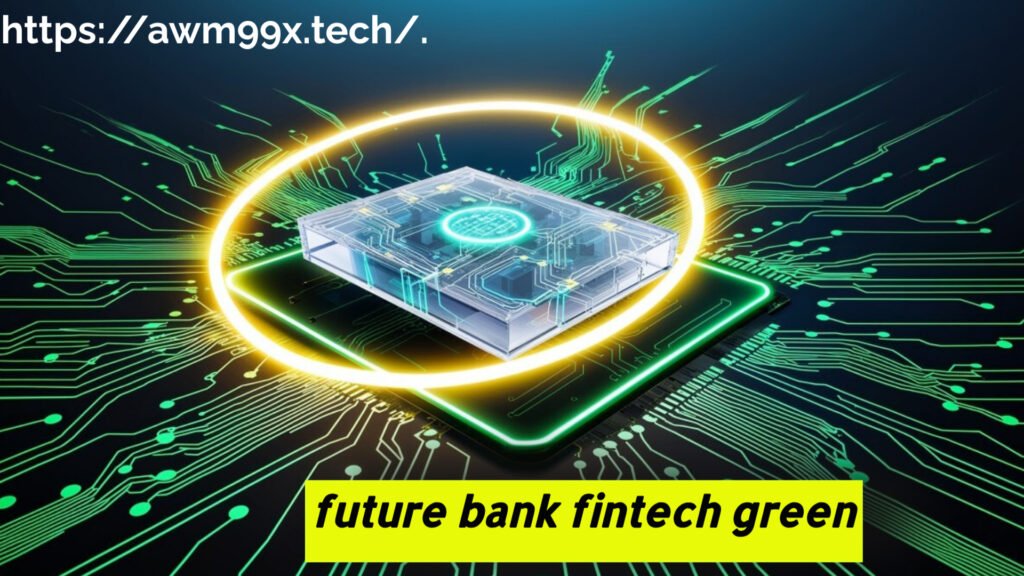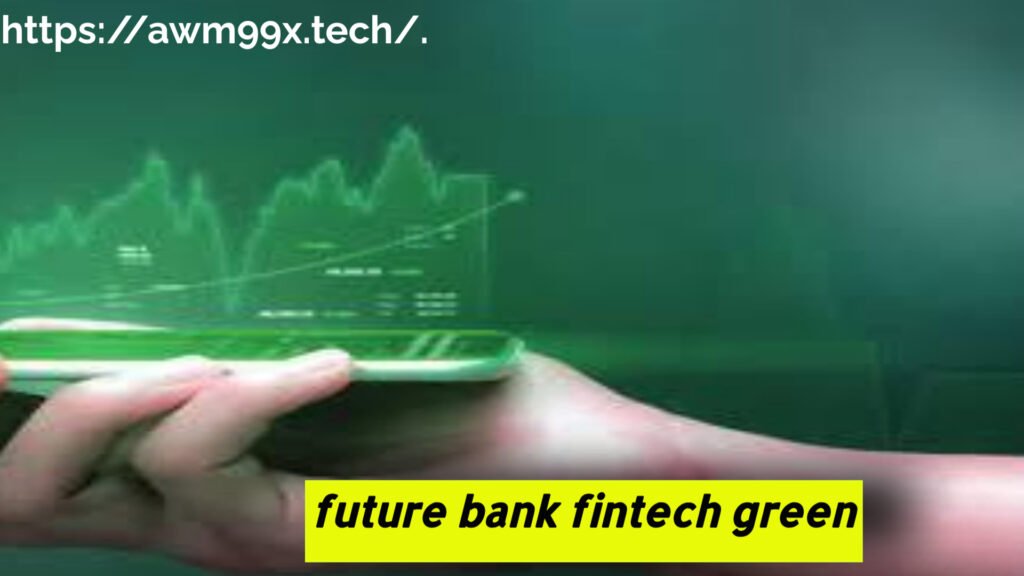The advancement of financial technology, termed ‘fintech’ has significantly changed the banking sector, as has the growing focus on sustainability. Here’s a revised, shorter version with sentence lengths below 20 words for readability. Conventional banking systems are fading as the Future Bank Fintech Green movement emphasizes sustainability in finance.
Banks and fintech companies are adopting climate goals to appeal to eco-conscious consumers. These shifts align with global sustainability goals, offering new investment opportunities in green initiatives.

What is Future Bank Fintech Green?
Future Bank Fintech Green refers to the current transformations in the banking system and technology which is green and focuses on sustainable development. This term includes incorporating and integrating green fintech into the existing banking systems for a better responsible financing space.
Investing in Future Bank Fintech Green is essential for the future of the industry. Such financial institutions that go green also have the chances of getting ecofriendly consumers, regulatory requirements and new business ventures. In addition to that, the increasing supplies of green funds shows an impressive market outlook on green investments which raises the viability of green fintech projects.
In the case of Buy Now Pay Later (BNPL) systems offered by banks and even fintechs, there is a possibility of misuse of these systems hence why they have to be sustainable. As lending responsibly is urged to be part of this BNPL solution, then it’s possible to raise pro-ecological behavior among consumers.
What is Green Fintech?
Green fintech refers to developing new ways of conducting finance with an emphasis on ecological sustainability. It offers a range of products and services designed to address climate change and other environmental issues. Major aspects of green fintech are:
Sustainable Investments: Financial products that are ethical in nature and that fund projects that are environmentally sound.
Carbon Tracking: Technologies that help individuals as well as corporate clients track their carbon emissions and use them to minimise their carbon emissions as well.
Digital Wallets: Systems that allow ecologically sound payments and which are aimed at funding greener projects.
By contrast to other instruments, green fintech emphasises environmental protection. If the primary aim of other players in the field of investing is clearly defined as attaining efficiency and profit only, green technologies practice extending these principles of efficiency and profitability into socially responsible investing.
$30 trillion is apparently a strong enough indicator reinforce these sentiments. These figures claim the marketplace for such financial instruments has exceeded $30 trillion which means the demand for responsible solutions is high.
Challenges in Green Fintech
Green financial integration has lots of promise but several challenges too-
Greenwashing: Mistrust towards consumers may surface if some of the financial players falsely promote the steps undertaken towards green growth. Such initiatives will help strengthen their credibility by providing essential information to banks and other institutions’ customers.
Technological Barriers: Most of the conventional banks invest less towards transitioning to greener technologies. Innovations in Green technologies need adequate funding from financial players.
Lack of Financial Literacy: Most consumers do not understand the concept of sustainable finance, thus leaving them disadvantaged in making choices. Educational initiatives provide paths to increased financial literacy since eco-friendly investments continue to gain acceptance.
These challenges must be projected carefully in order to propel real change across the board in the fintech space. Growth of green fintech would be stunted if there is lack of transparency and initiatives to promote sustainability aimed.
The Transition to Sustainable Finance
There has been an upsurge in demand from consumers willing to bank on sustainable practices. The products that go to today’s customers have been properly designed to ensure that money does not have a negative effect on the ecological wellbeing.
Studies show that three in ten consumers, or 68%, regard ecological responsibility as a key factor when selecting a financial service. It does not matter that this practice is still at an early stage: banks already have to include sustainability into their offerings.
It is also the case that sustainable finance is supported by regulation and international agreements. The United Nations’ initiatives, such as the Net-Zero Banking Alliance for example would be a good example of such initiatives that assist sensitize banks to global issues and setting all over the world to achieve net zero by 2050.
Similarly as governments act to enforce their climate considerations, so do the banks so as to act compliant to such regulations.
Sustainable finance goes beyond just complying with regulations. It is a source of business development. As consumer preferences change towards sustainability, so will the demand for eco-friendly banking opportunities. Interest in funds using sustainable practices is also on the rise since it indicates that they are funding eco-friendly projects.

Technological Innovations Driving Green Finance
All explained so far signals that green finance must depend on technological innovations. In particular, these technologies are maturing and becoming more prevalent in modern banking:
Cloud Computing: In addition to allowing banks to store and utilize large amounts of data, they reduce the bank’s emissions due to less physical infrastructure being necessary. Now businesses have access to more efficient and scalable solutions.
Blockchain Technology: Blockchain makes financial transfers and transactions more transparent and allows making sure that funds are spent on the planned measures funded for sustainable purposes. This technology can also facilitate carbon credits trading, which will help companies to lower their carbon footprints.
Mobile Banking: Digital finance solutions such as mobile applications help people manage funds without going to the nearest physical branch or receiving paper-based statements. This is because users can log into their accounts wherever they are and initiate transactions.
Real-time Payments: Timely payment systems are now made possible through fintech services which reduce the carbon emissions that these technologies would have caused before.
Today many startups exhibit successful developments in green fintech. For example, Tomorrow is a blockchain based German bank which incorporates sustainable banking and specializes in financing green projects. TreeCard has developed a debit card that donates a dollar to plant a tree for every dollar spent which helps promote green initiatives and modern banking methods.
Future Opportunities for Banks and Fintechs
With adopting uneconomical practices, there are numerous prospects for both banks and the fintechs-
New Markets: Non-sustainable products can open access to new new markets. Offering such products is only feasible by banks planning to target eco-aware customers.
Operational Benefits: Sustainability helps in augmenting efficiency and also bettering customers’ loyalty providing better solutions and growth for banks. A banks pledge to corporate social responsibility can also enhance customers’ trust thus growing the bank’s market share.
Partnerships: Unions of fintech companies with the traditional banks help to innovate and offer unprecedented services. These connections help to create innovative solutions by combining skills and resources.
Banks that adopt a sustainability finance strategy are on the right course because it’s not only what investors want, but it is the trend in the market for these institutions. The banking sector will gradually be based on an ability to integrate and meet the needs of consumers towards organic solutions.

Instances of Achievements from Green Fintech Sector
It is important to demonstrate the potential of green fintech because several banks have already adopted some of the sustainable practices. A few examples are:
Triodos Bank: The focus of this bank is financing projects that are sustainable only. By promoting itself as eco-friendly banking, Triodos has invested in renewable energy, social housing, and sustainable agriculture. Their customers appreciate their openness and impact investment strategies, which earned their loyalty.
Bank of the West: This bank has offered green bonds to its customers, enabling them to support environmental projects. Their approach towards sustainability includes advancing renewable energy projects and financing sustainable businesses.
Aspiration: This tech firm offers eco-conscious banking solutions, including a spending account that enables its users to view their carbon usage. They also have clear strategies for the application of the Aspiration Impact Measurement (AIM), which allows users to evaluate the outcomes of their spending on social and environmental resources.
Such implications provide evidence of how green fintech can not only transform the banking industry, but also has the impact to reshape the society into being more responsible and sustainable.
Conclusion
The Future Bank Fintech Green approach is reshaping finance, blending banking with sustainability. Green fintech, carbon tracking, and ESG investments help banks not only meet consumer demand but also boost resilience. With eco-friendly practices, digital tools, and ethical finance options, financial institutions can support both economic growth and environmental health.
This shift to sustainable banking offers new investment paths and helps banks align with a green future. By investing in green funds and adapting innovative tech solutions, they can create a positive impact, fostering a financial world that balances profit with planet-friendly practices.











2 thoughts on ““Future Bank Fintech Green: Transforming Sustainable Finance””